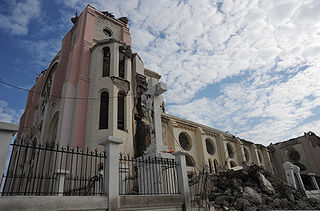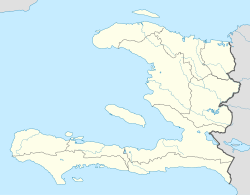
Ouest (French) or Lwès is one of the ten departments of Haiti and located in Centre-Sud of the country linking the Great-North and the Tiburon Peninsula.

Sud-Est (French) or Sidès is one of the ten departments of Haiti located in southern Haiti. It has an area of 2,034.10 km2 and a population of 632,601 (2015). Its capital is Jacmel.

Benoit Joseph André Rigaud was the leading mulatto military leader during the Haitian Revolution. Among his protégés were Alexandre Pétion and Jean-Pierre Boyer, both future presidents of Haïti.

Jacmel is a commune in southern Haiti founded by the Spanish in 1504 and repopulated by the French in 1698. It is the capital of the department of Sud-Est, 24 miles southwest of Port-au-Prince across the Tiburon Peninsula, and has an estimated population of 40,000, while the commune of Jacmel had a population of 137,966 at the 2003 Census. The town's name is derived from its indigenous Taíno name of Yaquimel. In 1925, Jacmel was dubbed as the "City of Light," becoming the first in the Caribbean to have electricity.

Tropical Storm Alpha was the 23rd tropical or subtropical storm of the extremely active 2005 Atlantic hurricane season. It developed from Tropical Depression Twenty-Five in the eastern Caribbean Sea on October 22, 2005. As the 21 pre-designated storm names had been exhausted, it was given the first name on the auxiliary list, which utilized the letters of the Greek alphabet. This was the first hurricane season ever to trigger this naming protocol, and the only one until the 2020 season.

Léogâne is one of the coastal communes in Haiti. It is located in the eponymous Léogâne Arrondissement, which is part of the Ouest Department. The port town is located about 30 km (19 mi) west of the Haitian capital, Port-au-Prince. Léogâne has a rich and unique culture, especially with regard to the arts, music, literature, cuisine, and architecture. It also holds importance for archaeological and historical sites such as Fort Campan.
The French name Marigot is given to several places in the Caribbean:

The Archdiocese of Port-au-Prince is a metropolitan archdiocese, responsible for the suffragan dioceses of Jacmel, Jérémie, Anse-à-Veau and Miragoâne and Les Cayes.
Bassin-Bleu is a commune in the Port-de-Paix Arrondissement, in the Nord-Ouest department of Haiti. It has 33,926 inhabitants. Bassin-Bleu is a home to a waterfall/pond also called Bassin-Bleu. They are a main tourist attraction. Bassin-Bleu in the Nord-Ouest department has a river running through it call Les Trois-Rivieres. The Bassin-Bleu with the waterfall is in the South of Haiti near the city of Jacmel.
Bainet is a commune in the Bainet Arrondissement, in the Sud-Est department of Haiti. It has 62,300 inhabitants.
Belle-Anse is a commune in the Belle-Anse Arrondissement, in the Sud-Est department of Haiti. It has 51,707 inhabitants.
Cayes-Jacmel is a commune in the Jacmel Arrondissement, in the Sud-Est department of Haiti. It has 36693 inhabitants. Cayes-Jacmel is down the road from Cyvadier and home to a lovely public beach and has a remarkable farmers market. The town is also home to amazing artists and artisans, including work in meticulously created miniature ships. The region's hydroelectric plant is nearby.

La Vallée is a commune in the Jacmel Arrondissement, in the Sud-Est department of Haiti. It has 36,188 inhabitants.
Jacmel is an arrondissement in the Sud-Est department of Haiti. As of 2015, the population was 338,728 inhabitants.
The history of the Jews in Haiti stretches from the beginning of the European settlement until the modern day.

Galathée was a 32-gun frigate of the French Navy, lead ship of her class.

Chibly Langlois is a Haitian cardinal of the Catholic Church. He has served as Bishop of Les Cayes since 15 August 2011, and is also president of Haiti’s Bishops’ Conference.
During the Haitian Revolution (1791–1804), Haitian women of all social positions participated in the revolt that successfully ousted French colonial power from the island. In spite of their various important roles in the Haitian Revolution, women revolutionaries have rarely been included within historical and literary narratives of the slave revolts. However, in recent years extensive academic research has been dedicated to their part in the revolution.
Romaine-la-Prophétesse, born Romaine Rivière around 1750 in Santo Domingo, was a free black coffee plantation owner and leader of an uprising early in the Haitian Revolution.











